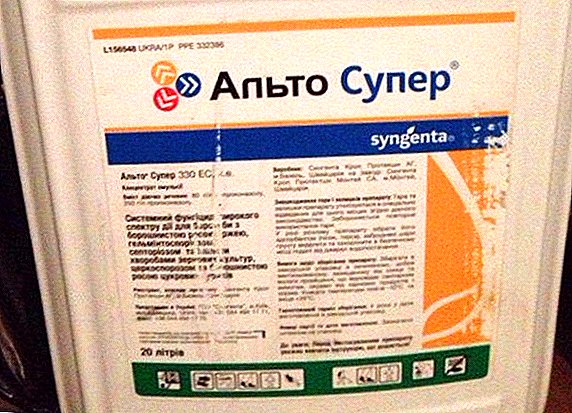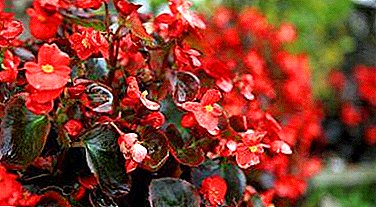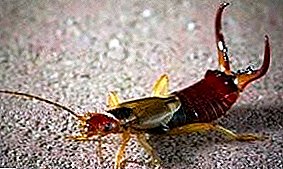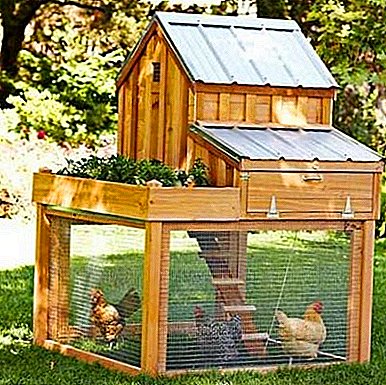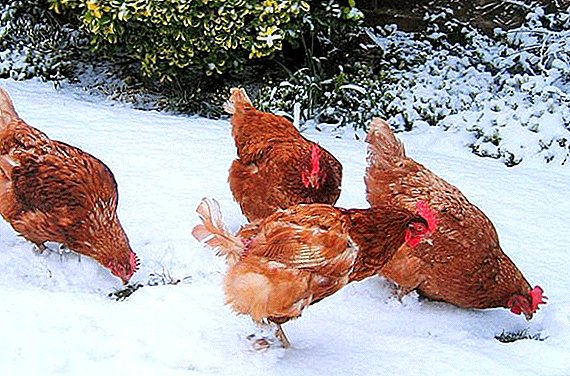 For the maintenance of chickens in winter, certain conditions are required. Birds need to create a favorable environment and then the bird will thank your labors by regularly laying eggs or putting on weight well. How to create an optimal environment for keeping chickens at home, you will learn from our article.
For the maintenance of chickens in winter, certain conditions are required. Birds need to create a favorable environment and then the bird will thank your labors by regularly laying eggs or putting on weight well. How to create an optimal environment for keeping chickens at home, you will learn from our article.
Features of the behavior of chickens in the winter
In the process of growing poultry it is necessary to pay special attention to the conditions of their housing. So in the summer period with this usually there is no difficulty, however, after cooling, the behavior of the birds also changes. 
In summer, their care includes a high content of greenery in the diet and the greatest possible free movement of open areas (it is desirable to make a fence from various predators). The result of proper care is good health and high bird productivity.
However, with the onset of cold weather, poultry farmers have noted a significant decrease in chicken egg production. This is due to the fact that to maintain the required body temperature, chickens consume more energy and move less, there is an increased need for additional mineral and vitamin elements.
Also on the behavior of the bird is affected by the lack of green food and reduced light day.
To maintain a good level of egg production in chickens during the winter period, it is necessary to properly organize their housing. After all, it is there that chickens will spend 80-90% of their time. 
Preparing a place of detention for the winter
Long before the onset of cold weather, it is necessary to begin preparing the site for the winter keeping of chickens. Now let's define what the conditions of poultry should be and how to provide them.
Chicken coop
This is the most ideal place to keep, especially if it has a robust and well thought out design. It must maintain optimal conditions for wintering chickens.
These conditions include:
- temperature regime, which is constantly necessary to maintain in the range from +12 to +18 degrees;
- humidity is recommended to maintain in the range of 60-80%;
- the air in the hen house should be constantly updated, but no drafts should be allowed to occur;
- lighting - in winter, chickens need an additional light source, the daylight hours of chickens should last 14 hours or more.

Before preparing the chicken coop for wintering, it is necessary to disinfect the room. This can be done with lime. It is diluted in a ratio of 2 kg per 10 liters of water. The resulting solution is treated with all surfaces.
Learn how to choose a chicken coop when buying, how to build a chicken coop with your own hands, how to make a chicken coop with your own hands, how to make a roost, how to make ventilation in a chicken coop, how to make a nest for chickens.
After disinfecting the chicken coop, it is necessary to examine it for the presence of drafts and crevices that will let the cold through. All slots must be well sealed. Windows, if present, should be tightly closed.
Simple actions to eliminate drafts will protect the birds of the chicken coop from diseases and will increase their productivity. In addition, it will help maintain a constant temperature.
Did you know? Laying eggs only in daylight. If it is time to chat, and it is dark in the hen house, she will wait for the day or the moment when the lights are turned on.

For lighting it is necessary to install a lamp, which will also serve as a means of additional heating of the room. In the process of its installation, you should choose a place so that the birds could not hurt themselves or harm the equipment.
If your region is systematically turning off the light, it is recommended to install an additional generator. It will allow you to avoid stressful situations in poultry, which can cause a disruption in egg production or lead to weight loss.
For additional energy savings, you can set a timer that will regulate the duration of daylight in birds.
If there is no warm room
Chickens are unpretentious birds that adapt well to various conditions. Therefore, you can keep them in any room, the main thing is to ensure optimal conditions for their maintenance. So, some poultry farmers use a garage or a greenhouse for this purpose. 
A room that is not heated needs to maintain a certain temperature. As a heating utility room, where in winter the temperature drops below +10 degrees, a gas heat gun, a stove, an electric heater or infrared lamps can be used.
In order for the feet of the birds not to freeze, it is worth spreading the litter. It can serve as a layer of straw or sawdust 5 cm thick. However, do not think that this litter will protect chickens for the whole winter.
It is able to accumulate moisture, and as it accumulates, it is necessary to pour a new layer. In the process of decomposition, the layer will emit heat, but it creates favorable conditions for the reproduction of pathogenic bacteria, therefore it is worth periodically cleaning the coop.
In the process of life, chicken manure emits ammonia. To protect the birds from toxic emissions, it is necessary to provide additional ventilation. 
When designing and building a ventilation system, an adjustable valve is required. It will allow to control the incoming air flow into the room.
If a greenhouse is used as a chicken coop, then a layer of snow can be poured on its sides. This layer will allow you to keep warm in the room.
Keeping chickens in winter
It is also worth paying special attention to the diet and feeding regularity, walks and day regimen. All these issues are important in the period of cold weather and an increased nutritional deficiency.
Nutrition
In winter, chickens need a balanced and well-thought-out diet. This will help them provide the same volume of eggs both in summer and in winter, and broilers will quickly gain weight. 
The decrease in egg production in laying hens is due to the fact that the chicken requires more nutrients to form eggs. With the onset of cold weather, the bird’s resources are rapidly decreasing and, accordingly, the volume of eggs it can carry.
Did you know? The layer is able to determine which egg has gone bad. If during the next collection of eggs you find some near the nest, then most likely they are spoiled.
For the cultivation of layers in the winter period, high-quality animal feed is required, which will contain the optimal combination of all the necessary elements, vitamins and even in some cases medications. Such feed can be purchased at the poultry market.
However, if you can not buy such a mixture, you can cook the feed. When preparing it, it is worth keeping a balance between proteins, fats and carbohydrates. Also worth using vitamin and mineral supplements. 
Cereals (corn, oats, barley and wheat), legumes, as well as meat and fish meal, salt, lime, chalk should be present in the diet of chickens. Cereals should be given more and more. As such, they are digested longer and provide an adequate level of energy for a longer time.
Find out what should be the diet of chickens than feed the laying hens.
Like any other animal, chickens need a variety of diet. In this regard, it is worth giving them fresh or boiled vegetables. The use of wet feed is allowed if they are prepared on the basis of warm water.
Herbal flour, which contains fresh-cut greens and all the necessary vitamins and minerals, can provide a balanced diet for chickens.
Feeding
Feed birds recommended 2 times a day. 
In this case, it is necessary to observe the procedure of feeding: in the morning they give mixed feed, and in the evening - cereals. Also do not forget about the products that facilitate the process of digestion. These products include sand, shell, or pebbles.
Important! In winter, poultry hosts may experience the appearance of a soft egg shell. This is due to the lack of calcium in the chicken, so it is necessary to increase the amount of minerals.
Water is of particular importance in the diet of birds. In cold weather, the drinkers can freeze, so you should change them regularly. It is not recommended to use cold water, as this may cause health problems of the hen. It is best to pour warm liquid.
Walking
If the bird does not provide an optimal amount of physical activity, then the health of the chicken and its effectiveness will suffer. Despite the low temperature, the animal needs a certain amount of sunbathing. 
Vitamin D, which is produced by chickens during the walk, contributes to the absorption of calcium by the body. Concerning Experienced poultry breeders recommend laying hens walking for 10-15 minutes every day..
The best place for a winter walk is an aviary, which does not allow to move freely around the site and protects them from predatory animals. For optimal walking, it is recommended to lay wooden flooring and straw in the aviary, this will protect the paws from frostbite.
Important! If the ambient temperature drops below -10 degrees, then it is not recommended to let chickens out for a walk, as the bird can freeze its paws. The ideal period for walking is thaw.
On the territory of the enclosure must provide a place for ash and sand. In the open air, chickens perform hygienic processing of feather cover. Ash and sand help clean the feathers, which prevents the parasites from reproducing. 
Daily regime
In summer, the day regime of chickens is comparable to daylight hours. However, while reducing the length of the day, poultry shortens their wakefulness period and often this fact affects their egg production. The effect of this factor can be minimized by artificial lighting, which allows you to adjust the mode of the day of the layers.
The optimal start of the day in winter should start from 6 to 9 in the morning. A precursor to the onset of the waking period may be artificial lighting. During this period, it is recommended to feed the poultry and replace the water with warm one.
The night falls between 6 and 9 pmThis period is accompanied by turning off the light. Thus, the duration of the day will be 12-14 hours, which is considered optimal for the chicken.
Observing the day regimen can facilitate a temporary relay that will automatically turn the lights on and off. It is better to accustom chickens to such a regime since November. 
Content Features
Creating optimal conditions for keeping chickens in the winter period will allow them to easily endure the winter cold without stress. However, it is worth considering some features of their content.
Laying hens
In the winter period, for the chickens to carry the same volume of eggs, it is necessary to monitor their litter. It should not be crushed and collected in one place. To avoid this, you need to regularly smooth it with a rake.
Learn about the most egg breeds of chickens, how to properly maintain the hens and how to breed the laying hens, as well as how to increase the egg production of chickens, why chickens do not carry eggs, why chickens carry small eggs.
In the autumn and spring, it is worth gradually increasing and decreasing the length of daylight hours in the hen house. Such a process will protect the bird from stress and, accordingly, will not allow its egg production to suffer.
It is very important to collect eggs in time. Otherwise, the hen will fill up the nutritional deficiencies of the egg. Evening food intake should contain grain, which will be digested at night and warm the bird. 
Do not forget about the hygiene of chickens. In the litter, which accumulates in the hen house, optimal conditions are created for the reproduction of pathogens. Therefore, it is very important to clean the house regularly.
Did you know? National Geographic researchers have shown that chickens can communicate with each other. And what a person perceives as a cluck or a click of a beak is in fact speech. They managed to identify about 30 separate phrases, ranging from "it is time for me to lay eggs" and to "danger, a predator is near."
Chickens
Growing poultry is not limited to laying hens. Poultry farmers often grow meat breed chickens. These breeds are capable of gaining up to 2.5 kg in a short period of time, however, compared with their relatives, they are quite demanding to care.
It will also be helpful for you to know how to grow chickens yourself, how to breed chickens using an incubator, how to feed chickens, how to prevent and how to treat chickens' diseases.
Proper care involves 2 stages:
- First stage requires keeping young chickens in a small cage, preferably with a pallet, which will facilitate cleaning. The use of such a cell provides for the location of the trough and the feeder outside. Another option may be the traditional use of the box or a small fence in a warm and heated room. But there are several advantages to using a cell. First, the cell is not disposable. Secondly, the external location of the feeder and the drinker will prevent the spilling of water and the scattering of food (which is especially important during the cold winter period).
- Second epap implies the maintenance of already grown up individuals in the floor pen. There are no special difficulties in its creation, however, it is necessary to choose the right place.

Both options should provide the basic conditions for optimal chick keeping:
- flooring - as for hens, it plays an important role and can include both hardwood flooring, and a layer of hay or sawdust, and its thickness should be at least 10 cm;
- lighting - natural light for chickens is not enough. It is better for them to provide round-the-clock lighting, which will also serve as a heater;
- heating - should provide a permanent source of heat, which may be a fireplace or a heater. In the first days, the temperature regime should be kept within + 35-36 degrees, and already at two months of age it will gradually decrease to + 18-20;
- feeding - food and water sources should be freely available;
- security - it is necessary to avoid stress, since broilers have a rather timid character. In a stressful situation, they tend to group in flocks and can cripple each other. Another negative consequence of stress is weight loss;
- hygiene - the place of chickens requires constant attention. It should be kept clean and dry, which will protect the bird from diseases.

An important factor is the diet and feeding regime. Since these birds are raised for meat, they must be fed regularly and balanced, in which case they will quickly gain weight. The diet of chickens should contain wet food, vegetables and cereals.
Feed must be 3 times a day. In the daytime you need to give a mash, which will consist of boiled vegetables, chopped hay and flour, for example, barley. Another 2 meals provide for corn feeding. Do not forget about the vitamin and mineral complex. It is recommended to add baker's yeast and chalk to wet food.
A light day for broiler chickens should be at least 18 hours a day.
For a quick weight gain, it is recommended to use more yellow foods in the diet, this will allow you to eat all the proposed food for 30 minutes. After eating, the food is cleaned so that it is not kis, but the lighting is muffled. A decrease in light contributes to a decrease in bird activity, and it adds weight. 
Keeping poultry requires attention, but thorough preparation for winter will facilitate the work. Many people can call such maintenance of chickens in winter a rather troublesome thing. However, it is able to provide fresh eggs and meat all year round.
And for enterprising people this can be a good basis for creating their own business.
Feedback from network users






